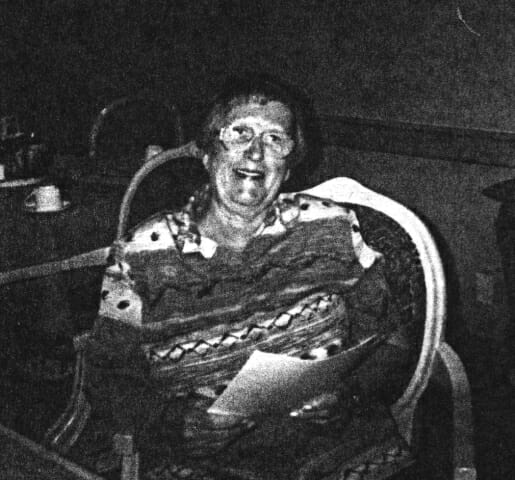Gastineau Channel Memories
Robinson, Walter & Fanny
Frances Robinson Smith
Fanny Smith met Walter Robinson while she was on a cruise vacation to Douglas, Alaska, where Walter worked in the Mill in 1915. Where Juneau had been a tent city, Douglas was where the work was available at that time. Fanny went back to Grand Forks, North Dakota, where she taught art, writing to Walter until he came back to Grand Forks to be married. He came from Cato, Wisconsin, but Alaska brought them together. They returned to Juneau where they spent almost a year on a friend?s boat, not much more than a dory. Fanny spent most of that time being seasick and finally pregnant with daughter Margaret.
Even though Walter worked days, every spare minute he and Fanny started hauling logs with a rowboat to furnish the piling on the lot which many years later adjoined the first bridge to span Gastineau Channel from Juneau to Douglas. Needless to say, it was a long grueling job. The land consisted of mud flats. It was free and there were no taxes in those days. When the piling were installed, they planked the lot and made plans for their home which later had the address of 1044 Tenth Street. Fanny had many creative ideas for 1915, many of which became common many years later.
Margaret attended the original Juneau Grade and High Schools on Fifth Street hill, starting in the second grade since Fanny had taught her to read phonetically and print. She did miss all but six weeks of her seventh grade. The family took a tour of twenty-one states but only as far as Chicago and then south to most of the southern states. They made the trip to Seattle on their 30-foot boat the Famawa (Fanny, Margaret, and Walter). They made it despite a barely adverted disaster crossing Seymour Narrows at the wrong tide.They were almost engulfed in whirlpools but somehow they survived.
The old 1920?s Dodge proved almost as hazardous. Walter had never driven a car before or since. With not much more than a drive around the block with the used car salesman, Walter drove to Bainbridge Island to pick up his family. He did not arrive until about midnight, running off country roads and almost hitting a tree. He was shaken but in one piece. That should have been a warning but lady luck was with them when not too long afterwards they turned the car over on its roof, shaken but unhurt. Happenings on this trip from then on were comparatively tame. Margaret learned more history and geography on that trip then she could ever have learned in school.
While still a child, Margaret?s dad still trolled for king salmon and carpentered for income. He would take Fanny and Margaret to Sitka and other villages where they always got seasick when out on the Pacific Ocean. He would tie them up to the mast allowing them just enough rope to reach the side of the boat to relieve themselves, never having any sympathy for being so ill. Smelling the fumes from the gas boat and slaughtering the fish didn?t help them feel any better either. Fortunately, as soon as they got on terra firmer they were okay.
Walter loved his lonely life of fishing by starting his day at 3:30 a.m. being at sea no matter what the weather. But after WW II, when the family was living in San Diego, he took the Famawa out for the last time. It sank in a storm but he survived with only the rowboat to save him as he was picked up by another boat. The Robinsons sold their house in Juneau. In the meantime, after Margaret had left Juneau, all the area surrounding the family house had been filled in with rock tailings from the Alaska-Juneau Mine. Finally the house, along with others, was torn down to make way for the Harris Boat Harbor next to a newer second bridge spanning Gastineau Channel.
After Margaret finished Juneau High School in 1933, she attended the Alaska College (the following year it became the University of Alaska) in Fairbanks for her freshman year. She waited tables which paid for room and board which at that time cost $40 a month. It was an interesting experience, skating between classes on a
flooded rink between the gym and main building. Margaret and her chum Katie were practicing hiking daily for months and decided when school was out they would send their trunks ahead and walk the railroad tracks to Nenana about fifty miles south of Fairbanks; pick up the train for Katie to continue to Anchorage and Margaret would catch the ship for Juneau in Seward. It was offhandedly mentioned to President Bunnell one day while Margaret was waiting his table. He almost hit the ceiling physically. ?I am in charge of you girls until you arrive home!? All their well-laid plans were down the tube.
The next year Margaret spent her sophomore year at Washington State in Pullman. It was a much different but enjoyable year. During the summer, she did part time office work in Juneau, finally working in the Disbursing Office in the Federal Building. Those were still Depression days. She had financed the second college year from the $800 she had saved over several years of raising rabbits, but could not continue college at that time.
Margaret met her husband Ernest Smith at a dance in Juneau and they were married in 1936. They bought a furnished home at the foot of Ninth and ?A? Street. Ernie worked in the Alaska-Juneau Gold Mine for five years as a bulldozer setting off the dynamite to free the low grade ore. It was a hazardous job but he did it well.
The Smiths had identical twin boys, Daniel Ernest and Donald Walter in St. Ann?s Hospital. Being the little Alaskans they were, physically they remained quite healthy. Dan is still alive, very healthy, and working on a truck at 63 years old. Don passed away at 42 years as he had many operations and at that time there were no
antibiotics to fight infections. Doctors in Seattle and California told us their thirties would be old age for them and that they both were severely retarded, never able to talk, so the sooner we put them in a state hospital the better it would be for all of us. Of course, we felt we could never part with them. So we moved to San Diego in 1940.
Ernie Smith passed away in 1982, at 71 years of age. He worked for the Recreation Department in San Diego for 28 years, 23 of those years as foreman at Mt. Hope Cemetery. Fanny Robinson died in 1960, and her husband, Walter, died in 1961, both in California.
After Ernie passed away, Margaret joined the Alaska-Yukon Chapter of the International Sourdough Club, being quite active until this past year. She enjoyed attending the 50th and 60th Juneau High School reunions plus a Holland America Cruise with a stop in Juneau about four years ago. The last reunion was held in July over the 4th where they celebrated on a huge flatbed decorated in red, white, and blue; balloons, top hats and gloves. They received ovations the whole parade route, surmising that the watchers marveled they were still alive and traveling!
As Margaret recounts her life, she realizes she?s spent good years and bad, but all in all, she has had a great interesting life, much love and friendship but most importantly, she will always be an Alaskan at heart.
 |
Margaret Robinson Smith. |
